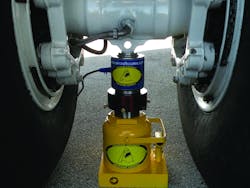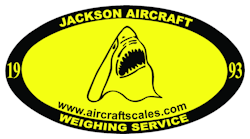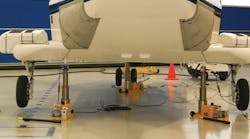Airframe Technology: To Weigh an Aircraft
New weight and balance information is regularly required for most all aircraft; small or large. Installation or removal of equipment, after repairs and modifications, or a frequent requirement of the aircraft or operators maintenance program, requires that the most accurate weight and balance data is available.
Weighing general aviation (GA) aircraft, helicopters, turboprops, corporate jets, or transport category airliners can be accomplished in two ways: top of jack load cells and platform scales. Equipment selection is dependent on the operator’s needs and or equipment currently on hand, as well as the airframe manufacturer's recommendations.
Top of jack load cells as the name implies, can be used on top of the current wing jacks or can be used under axle for larger jets. Platforms are very useful for small shops that do not have jacks for every type of aircraft. All you need is the ability to pull the aircraft onto the platforms and take your weight readings.
Equipment types
Top of jack systems:
The standard aircraft scale is a top of jack, cell-based scale, where each jack point receives a cell-based transducer on the top of the jack. This system's advantage is, it is very easy to use and level the aircraft during the weighing operation. The system is easy to transport, light weight, and easy to set up.
The operator must have a jack capable of receiving and mounting the cell. Check your jack ram tops for the 1-inch mounting hole; if you do not have the hole, adapters can be provided to assist in the interface required to mount the cells. Cells come in many weight ranges and are dependent on the weight required per point to accomplish the weighing and receiving the actual jack point type.
Platform systems:
Platforms are available in many weight ranges and sizes, these systems either use ramps or the aircraft can be jacked and lowered onto the platforms during regular maintenance. Platforms are easy to use and are a choice for many shops that do not have jacks for the many types of aircraft to be serviced.
The limiting factors for platforms are the weight range and the tire size, some aircraft have large tires and the platform may be too small for the specific aircraft tire. Always use the right size scale and platform for the aircraft type and weighing job you're doing.
Both types of scales feature new technologies using digital indication. Mechanical or analog meter scales have mostly been replaced with the new digital indicators. These indicators are very accurate and easy to use, cranking handles and thumb wheels are a thing of the past, making the weighing job faster to do and giving much higher quality in readings.
Weighing basics
Scales are like torque wrenches and you would not use a 100 foot-pound torque wrench to torque a 20 iinch-pound nut. Why then would you use a 150,000-pound scale system to weigh a light GA aircraft, turboprop, or helicopter? We see this practice a lot where many shops and or technicians use large scale systems to weigh light aircraft, or they have the wrong size cell top to fit a large jet jack point.
There are many military surplus scale units out there, be careful, many of these units still in use are analog meter movements and may or may not be calibrated correctly. When calibrating scale equipment we always recommend using an aviation-based calibration lab with an Airframe and Powerplant certified technician on staff or returning the unit directly to the manufacture for calibration. Some units require specific calibration procedures, software access, and or adapters; to complete the calibration properly always audit your provider to ensure that the proper procedures and equipment are being used. Primary National Institute of Science and Technology (NIST) traceable certifications and test equipment are a must.
Safety and use of the equipment is always a big factor. Always follow the aircraft or helicopter manufacturer's recommendations when jacking and or towing aircraft for weighing.
Equipment selection
Scale selection should start with the weight range needed and jack point or tire size must be considered. Small to medium aircraft will use a small cell with a 1-inch or smaller jack point. The jack points must fit into the cell concave top and be retained to prevent a cell to jack point ejection or spit during jacking. Larger cells will be used for larger aircraft weight ranges and larger jack points.
The decision point for cell and cup size will be at the medium to large jet selection. Regional jet aircraft and large corporate aircraft are usually the aircraft type at which a large cell kit will have to be used due to their larger jack points. We have often seen a small 50,000-pound cell being used for larger aircraft. In many cases this may have the weight capacity but not the retention and proper fit for the jack point.
For platforms, consider the tire size and ability to chock the tire on the platform to prevent movement. Equipment used to locate the aircraft on the platform and proper ramp selection are also important points to consider. It’s tempting, but never consider using automotive-style scales or 1 percent accuracy platform units as these units do not have the accuracy or resolution required for aviation use.
Always read and understand the scale manufacturer's manual as well as the airframe manufacturer's manuals prior to weighing and selection of the type scale to use. Aircraft maintenance personnel must understand the process, procedure, and instructions; remember to use the right tool for the right job.
Resolution and accuracy
As a general rule scales less than 10,000-pound capacity will measure in a 1-pound count and scales over that and up to 25,000 pounds will count in a 2-pound count. Large jet 50,000-pound scales will measure in a 5-pound count and so on. Always use a scale with the proper size and count resolution. The idea is to pick the right scale size and resolution for the aircraft type and accuracy needed.
Accuracy for aviation use is touted to be one-tenth of 1 percent or three indicator divisions, whichever is higher to full span. This is a release tolerance for the unit as calibrated and released from the lab and quality scales will meet this specification.
In the field tolerance is a different story. In general the tolerance expected in use would be one-fourth of 1 percent or five divisions to span. Due to the application, jacking, level of the hangar floor, and attention of the technicians conducting the job, there will always be variables in the weighing. Aircraft weights from point to point in rotation should be within range of the target weight from the old weight and balance.
Conclusions
When selecting a scale system it is very important to remember to select a scale that is first and foremost, the correct type, the correct size, and has the correct weight range for the application. The aircraft manufacturer’s manual shall always be consulted for the proper selection and directions. Some manufacturers do not recommend a particular scale or type. In these cases you must look at the technical data provided to do the job, the calculations, formulas, and any charts that are provided. Many manufacturers will include the jack point locations and wheel center locations in their manuals, so it is up to you to decide which type of scale to use.
Larry Jackson holds an Airframe and Powerplant certificate with Inspection Authorization and has 31 years of experience in the maintenance and care of all types of aircraft and helicopters. His company www.aircraftscales.com is a division of Jackson Aircraft Weighing Service. For more information call (561) 281-6179 or visit the web site.



